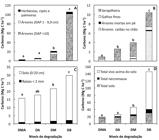Riparian forests provide essential ecosystem services to humanity, but are being degraded at an accelerated rate in the Amazon. This study aimed to quantify carbon stocks above and below ground in riparian forests with four levels of degradation (very high, high, medium and low) in two watersheds (Pepital Rio and Rio Grande) in Alcântara, Eastern Amazon. Twenty-four permanent plots of 1,000 m2 were installed, and vegetation (trees, shrubs, herbs, lianas and palms), necromass (litter, dead trees, branches) and soil (0-20 cm and roots) were sampled. The biomass was estimated using allometric models (vegetation with dbh> 1 cm and dead trees) and destructively (herbaceous, litterfall, branches, roots). The total carbon stock in the most conserved riparian forests ranged between 88 and 202 Mg(C) ha-1. Degradation significantly reduced carbon stock in all compartments (up to 97% in above-ground biomass, up to 91% of necromass, and up to 47% in soils). In conserved areas, the aboveground biomass is the largest compartment of the total carbon stock (> 70%), mainly due to large trees. The carbon stock in the different compartments are strongly correlated with each other and with the canopy opening. The incorporation of these results in regional carbon models can assist in the implementation and review of the Brazilian Forest Act, particularly in the restoration of riparian forests where agriculture is consolidated.
Maranhão; riverine forests; forest conservation; ecosystem services; ecological succession

 Impact of degradation on carbon stock of riparian forests in the eastern
Amazon, Brazil
Impact of degradation on carbon stock of riparian forests in the eastern
Amazon, Brazil Thumbnail
Thumbnail
 Thumbnail
Thumbnail
 Thumbnail
Thumbnail
 Thumbnail
Thumbnail





